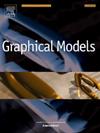双三次b样条插值曲面的Jacobi-PIA算法
IF 2.5
4区 计算机科学
Q2 COMPUTER SCIENCE, SOFTWARE ENGINEERING
引用次数: 3
摘要
本文基于配置矩阵的Jacobi分裂,开发了双三次b样条曲面的Jacobi - pia格式。首先提出了矩阵积形式的Jacobi-PIA格式,它比矩阵向量积形式具有更高的计算效率。为了分析Jacobi-PIA的收敛性,我们利用Kronecker积的性质将矩阵乘积迭代格式转化为等价的矩阵向量乘积格式。我们证明了在最优松弛因子下,双三次b样条曲面的Jacobi-PIA格式收敛于插值曲面。数值结果也证明了该方法的有效性。本文章由计算机程序翻译,如有差异,请以英文原文为准。
Jacobi–PIA algorithm for bi-cubic B-spline interpolation surfaces
Based on the Jacobi splitting of collocation matrices, we in this paper exploited the Jacobi–PIA format for bi-cubic B-spline surfaces. We first present the Jacobi–PIA scheme in term of matrix product, which has higher computational efficiency than that in term of matrix-vector product. To analyze the convergence of Jacobi–PIA, we transform the matrix product iterative scheme into the equivalent matrix-vector product scheme by using the properties of the Kronecker product. We showed that with the optimal relaxation factor, the Jacobi–PIA format for bi-cubic B-spline surface converges to the interpolation surface. Numerical results also demonstrated the effectiveness of the proposed method.
求助全文
通过发布文献求助,成功后即可免费获取论文全文。
去求助
来源期刊

Graphical Models
工程技术-计算机:软件工程
CiteScore
3.60
自引率
5.90%
发文量
15
审稿时长
47 days
期刊介绍:
Graphical Models is recognized internationally as a highly rated, top tier journal and is focused on the creation, geometric processing, animation, and visualization of graphical models and on their applications in engineering, science, culture, and entertainment. GMOD provides its readers with thoroughly reviewed and carefully selected papers that disseminate exciting innovations, that teach rigorous theoretical foundations, that propose robust and efficient solutions, or that describe ambitious systems or applications in a variety of topics.
We invite papers in five categories: research (contributions of novel theoretical or practical approaches or solutions), survey (opinionated views of the state-of-the-art and challenges in a specific topic), system (the architecture and implementation details of an innovative architecture for a complete system that supports model/animation design, acquisition, analysis, visualization?), application (description of a novel application of know techniques and evaluation of its impact), or lecture (an elegant and inspiring perspective on previously published results that clarifies them and teaches them in a new way).
GMOD offers its authors an accelerated review, feedback from experts in the field, immediate online publication of accepted papers, no restriction on color and length (when justified by the content) in the online version, and a broad promotion of published papers. A prestigious group of editors selected from among the premier international researchers in their fields oversees the review process.
 求助内容:
求助内容: 应助结果提醒方式:
应助结果提醒方式:


